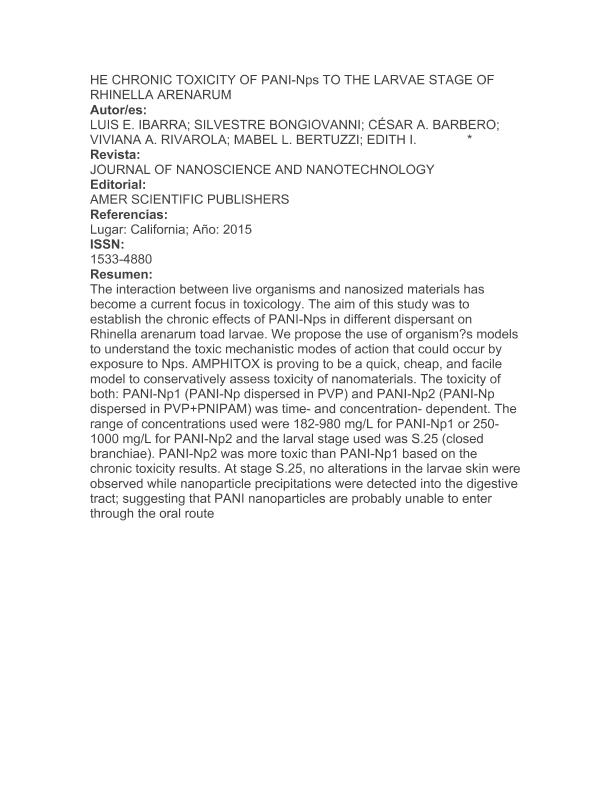Artículo
The chronic toxicity of PANI-Nps to the larvae stage of Rhinella Arenarum
Ibarra, Luis Exequiel ; Bongiovanni Abel, Silvestre Manuel
; Bongiovanni Abel, Silvestre Manuel ; Barbero, César Alfredo
; Barbero, César Alfredo ; Rivarola, Viviana
; Rivarola, Viviana ; Bertuzzi, Mabel Lucia; Yslas, Edith Inés
; Bertuzzi, Mabel Lucia; Yslas, Edith Inés
 ; Bongiovanni Abel, Silvestre Manuel
; Bongiovanni Abel, Silvestre Manuel ; Barbero, César Alfredo
; Barbero, César Alfredo ; Rivarola, Viviana
; Rivarola, Viviana ; Bertuzzi, Mabel Lucia; Yslas, Edith Inés
; Bertuzzi, Mabel Lucia; Yslas, Edith Inés
Fecha de publicación:
08/2016
Editorial:
American Scientific Publishers
Revista:
Journal of Nanoscience and Nanotechnology
ISSN:
1533-4880
e-ISSN:
1533-4899
Idioma:
Inglés
Tipo de recurso:
Artículo publicado
Clasificación temática:
Resumen
The interaction between live organisms and nanosized materials has become a current focus in toxicology. The aim of this study was to establish the chronic effects of PANI-Nps in different dispersant on Rhinella arenarum toad larvae. We propose the use of organism?s models to understand the toxic mechanistic modes of action that could occur by exposure to Nps. AMPHITOX is proving to be a quick, cheap, and facile model to conservatively assess toxicity of nanomaterials. The toxicity of both: PANI-Np1 (PANI-Np dispersed in PVP) and PANI-Np2 (PANI-Np dispersed in PVP+PNIPAM) was time- and concentration- dependent. The range of concentrations used were 182-980 mg/L for PANI-Np1 or 250-1000 mg/L for PANI-Np2 and the larval stage used was S.25 (closed branchiae). PANI-Np2 was more toxic than PANI-Np1 based on the chronic toxicity results. At stage S.25, no alterations in the larvae skin were observed while nanoparticle precipitations were detected into the digestive tract; suggesting that PANI nanoparticles are probably unable to enter through the oral route.
Palabras clave:
RINHELA ARENARUM
,
PANI
,
NANOPARTICLES
,
POLYMER
Archivos asociados
Licencia
Identificadores
Colecciones
Articulos(CCT - CORDOBA)
Articulos de CTRO.CIENTIFICO TECNOL.CONICET - CORDOBA
Articulos de CTRO.CIENTIFICO TECNOL.CONICET - CORDOBA
Citación
Ibarra, Luis Exequiel; Bongiovanni Abel, Silvestre Manuel; Barbero, César Alfredo; Rivarola, Viviana; Bertuzzi, Mabel Lucia; et al.; The chronic toxicity of PANI-Nps to the larvae stage of Rhinella Arenarum; American Scientific Publishers; Journal of Nanoscience and Nanotechnology; 16; 8; 8-2016; 7983-7990
Compartir
Altmétricas



